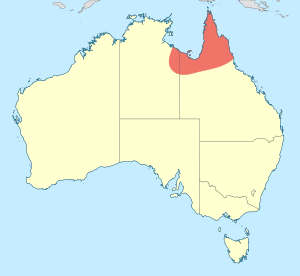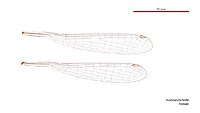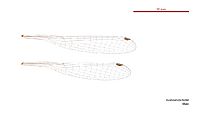Eastern pondsitter facts for kids
The Eastern pondsitter, scientifically named Austrosticta frater, is a fascinating type of damselfly. These graceful insects are often seen fluttering around water. The Eastern pondsitter belongs to a family of damselflies called Isostictidae.
Quick facts for kids Eastern pondsitter |
|
|---|---|
| Conservation status | |
| Scientific classification | |
 |
Contents
Meet the Eastern Pondsitter
The Eastern pondsitter is a medium-sized damselfly. It has a rather plain look, being mostly a dull grey-brown color. However, it does have some lighter, pale markings on its body. These markings can help it blend in with its surroundings, like plants and rocks near water.
Where Do They Live?
This special damselfly has only been found in one part of the world: northern Queensland, Australia. It loves to live near water, especially ponds. It might also be found near streams, which are smaller rivers. These watery places are important for the damselfly's entire life cycle, from egg to adult.
Damselflies vs. Dragonflies
Many people confuse damselflies with dragonflies. While they are both part of the same insect group called Odonata, there are a few easy ways to tell them apart:
- Wings at rest: Damselflies usually hold their wings together over their back when they are resting. Dragonflies, on the other hand, typically hold their wings spread out flat to the sides.
- Body shape: Damselflies often have thinner, more delicate bodies compared to the sturdier bodies of dragonflies.
- Eyes: Damselflies have eyes that are usually separated and don't touch each other. Dragonflies often have large eyes that meet in the middle of their head.
Life Cycle of a Damselfly
Like many insects, damselflies go through different stages in their life.
- Eggs: Female damselflies lay their eggs in or near water, often on aquatic plants.
- Nymphs: Once the eggs hatch, tiny creatures called nymphs emerge. These nymphs live underwater and breathe using gills. They are predators, hunting small aquatic insects and other tiny creatures.
- Adults: After several months or even years, the nymph crawls out of the water, sheds its skin one last time, and transforms into the beautiful winged adult damselfly we see flying around. The adult damselfly's main job is to find a mate and lay eggs, continuing the cycle.
Gallery




